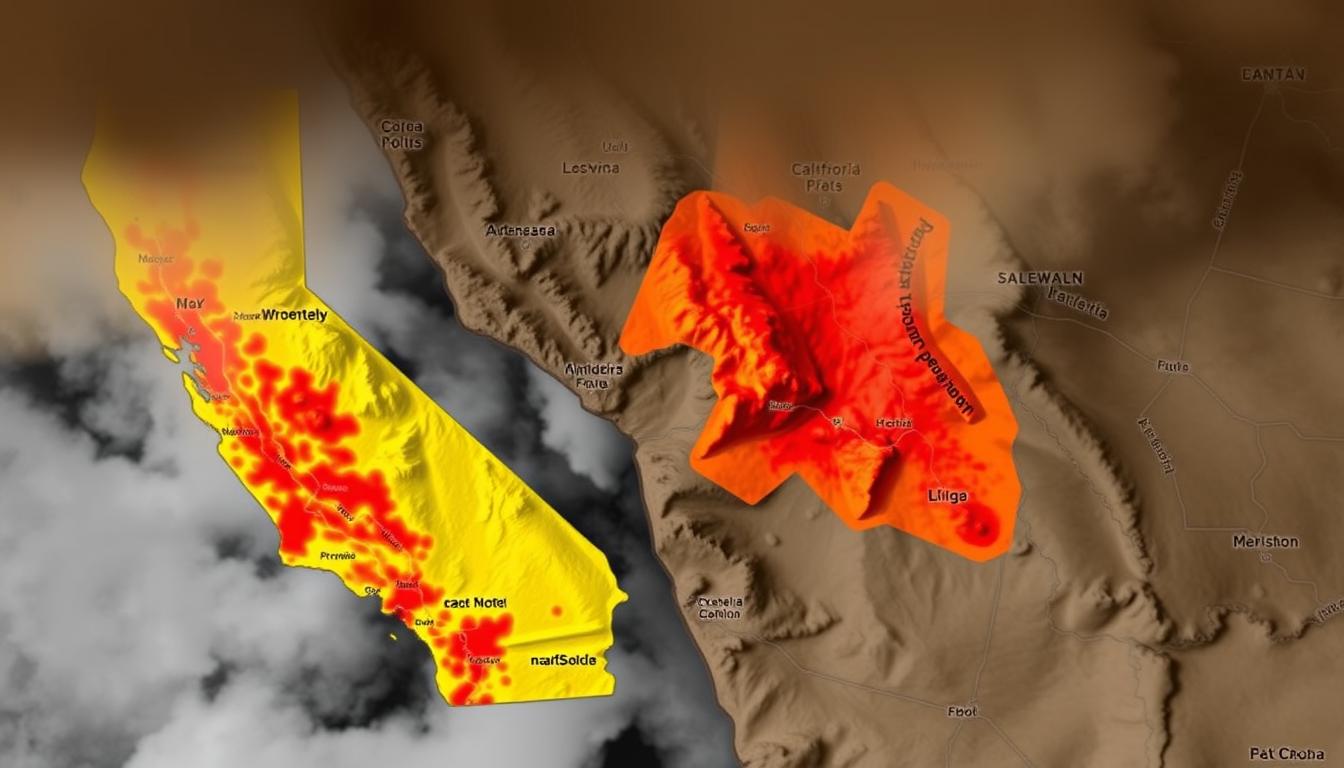The California fires map is key for those in or near the state, especially during wildfire season. In 2023, there were 7,127 wildfires and 324,917 acres burned. Keeping up with wildfire locations is now more important than ever.
California’s weather, with hot summers and strong Santa Ana winds, raises wildfire risks. This map lets people track active fires and evacuation orders in real-time. It helps them make smart choices during emergencies.
The Frontline Wildfire Defense App makes this data easier to access. It gives users real-time fire updates and evacuation notices. This ensures their safety.
Key Takeaways
- California’s climate contributes to high wildfire risk, particularly during summer months.
- The real-time updates in the California fires map can save lives during emergencies.
- Monitoring wildfire locations helps individuals efficiently plan evacuations.
- The Frontline Wildfire Defense App offers direct access to fire alerts and evacuation notifications.
- Understanding fire dynamics aids residents in taking proactive safety measures.
Understanding the Importance of a Wildfire Map
Keeping an eye on wildfires is key for public safety. A good wildfire tracking tool lets communities act fast when fires get close. With fires burning over 170,000 acres in northern California, having the right data is vital.
It helps with evacuation plans and lowers risks. This is especially true in California, where wildfires are a big problem.
Why Monitoring Wildfires Matters
Wildfires harm the environment and people. Over 200,000 people had to leave their homes because of fires. Also, about 3,500 buildings were lost.
Using a wildfire tracking tool helps people stay safe. It gives updates on fires, helping with evacuation plans. This can save lives.
The Impact of Wildfires on Communities
Wildfires cause more than just damage to buildings and loss of life. They also hurt the economy, especially in California’s wine industry, worth $58 billion. Smoke can damage crops, adding to the problems.
A community that knows about wildfires can protect itself better. A good tracking tool helps by showing smoke density and fire areas. This helps keep people safe and understand risks.
How to Access the California Fires Map
Getting the latest on the california fire map now is key for knowing about fires in California. This map is a crucial tool, showing where wildfires are and where to evacuate. State and community groups help share this important info in real-time.
Official State Resources
CAL FIRE is the top place to find the latest california fire map now. Their website has a detailed interactive map of fires in California. Here, you can find:
- Locations of ongoing wildfires
- Status updates on firefighting efforts
- Coordination with local emergency services
Community-Sourced Maps
Community maps also give local views on fires. These platforms let people share what they see, helping everyone understand the fires better. By using these maps, you can see what’s happening near you. People share:
- Images and videos of fire progression
- Reports on air quality and road closures
- Updates from neighborhood monitoring groups
Using both state and community maps helps us stay informed about fires. This is especially important during emergencies. Knowing where to find this info can help you make quick, safe choices.
Reading the California Fires Map: A Quick Guide
It’s crucial to know how to read the California Fires Map. This map uses symbols and colors to show fire activity and danger. It helps you make quick decisions.
Key Symbols and What They Mean
The map has symbols that tell important information, such as:
- Fire Perimeters: Show the boundaries of active wildfires.
- Evacuation Zones: Mark areas where residents must leave to ensure their safety.
- Fire Danger Zones: Color-coded sections that indicate the severity of fire conditions in specific areas.
Different Color Codes Explained
Color codes help show fire danger levels:
| Color | Meaning |
|---|---|
| Red | Active wildfire with high fire danger zones |
| Orange | Reported containment progress with ongoing threats |
| Yellow | Low containment progress with manageable fire danger zones |
| Green | No active fires; considered safe areas |
Knowing these symbols and colors helps you understand your area. The recent wildfires in Southern California show the need to know fire danger zones. It’s important to stay updated for safety.
Real-Time Updates on Active Fires
Knowing about wildfires is key, especially when they’re active. Real-time updates help by sharing info on where fires are, evacuations, and how they’re being fought. Many tools are out there to help people stay updated.
Using Social Media for Instant Alerts
Social media is now a top way to get quick updates on wildfires. Local groups often use Twitter and Facebook to share urgent news fast. By liking and sharing these posts, people can spread the word in their communities.
This helps everyone know about fire dangers and risks right away.
Trusted News Outlets for Updates
News sites like CNN, ABC, and local stations also offer important wildfire updates. They cover big fires, how they’re being controlled, and the effects on people. Their detailed reports add to the info from social media.
By using both, people get a full picture of the situation. This helps them prepare better.
Preparing for Evacuations: What You Need to Know
California residents, especially those in fire-prone areas, must focus on evacuation planning. Knowing how to make an evacuation plan can save lives and reduce panic. A good plan includes clear escape routes, meeting places, and ways for family members to communicate.
Creating a Family Evacuation Plan
To make a solid family evacuation plan, think about these points:
- Find two or more ways to leave your home and neighborhood.
- Pick a meeting spot outside the danger zone.
- Set up a way for family members to check in with each other.
- Plan for pets, including how to take them and what supplies to bring.
- Practice the plan often so everyone knows what to do.
Essential Items to Pack
When evacuating, it’s key to pack the right items. The USDA says to bring enough water and food for two to three days. The Los Angeles Fire Department also stresses the need for an emergency kit. Here are some items to consider:
| Essential Item | Purpose |
|---|---|
| Water | To stay hydrated — at least one gallon per person per day. |
| Non-perishable Food | To give energy and food during the evacuation. |
| Medications | To manage health conditions and prevent emergencies. |
| Important Documents | To protect identity and for easy access after evacuation. |
| First Aid Kit | To treat injuries during the evacuation. |
| Clothing | To keep warm and comfortable during and after evacuation. |
| Pet Supplies | To care for your animals during the evacuation. |
Having a detailed evacuation plan and packing these items can greatly improve safety and efficiency during wildfires. With California facing many wildfires, it’s crucial for all residents to be better prepared.
Tracking Fire Management and Response Efforts
Fire management agencies are key in fighting wildfires and keeping people safe. Groups like CAL FIRE and the U.S. Forest Service work together. They track fires, plan containment, and share important info with communities.
Agencies Involved in Fire Management
It’s crucial for different fire management groups to work together. They use up-to-date data to understand the situation and send help where it’s needed. Here’s a list of some important agencies and their roles:
| Agency | Responsibilities |
|---|---|
| CAL FIRE | Lead agency for wildfire suppression in California. |
| U.S. Forest Service | Manages national forest land and implements forest fire prevention strategies. |
| Local Fire Departments | Respond to fires and assist in local operations during emergencies. |
Understanding Fire Containment Strategies
It’s vital to have good plans to stop wildfires from spreading. Fire management teams use many methods, like:
- Regular updates on fire perimeter data every 12 hours.
- Hot spot tracking that occurs twice daily on a 1km scale.
- Assessment of wind patterns to forecast fire growth and movement direction.
These plans help put out fires and protect communities. Keeping air clean is also important, especially for kids and others at risk. Many apps offer updates on fires in real-time.
The Role of Technology in Wildfire Tracking
Technology is key in tracking and responding to wildfires. It helps monitor fires and keeps communities informed. With wildfires on the rise in California, using these tools is more important than ever.
Mobile Apps for Fire Alerts
Apps like the Frontline Wildfire Defense App offer crucial features. They send alerts about fires and evacuation orders. This ensures people know what’s happening as fast as possible.
Satellite Imagery and Its Uses
NASA’s satellite tech is vital for watching fires in California and elsewhere. Satellites can track fires for hours, giving vital data. For example, California uses AI tools to spot smoke from far away.
These tools can see heat, make images, and quickly tell fire departments about dangers.
Here’s a table showing some tech used in fighting wildfires:
| Technology | Description | Impact |
|---|---|---|
| AI-Powered Detection | PriviNet’s system detects smoke and identifies heat. | Fast-tracks response times for fire departments. |
| Drones | Used for mapping firefighting efforts. | Increases safety for personnel by monitoring from above. |
| Satellite Imagery | Navigates real-time fires globally, providing critical data. | Enhances awareness of widespread fire threats. |
| LiDAR Technology | Creates detailed 3D maps of high-risk areas. | Improves targeting of resources for fire prevention. |
These technologies help track fires in real-time and understand fire behavior. They make communities more ready for wildfires. To stay informed, check the california fire map now.
Community Resources During Wildfires
During wildfires, the community’s support is crucial. Local groups work hard to help those affected. They provide vital services, making sure no one faces wildfires alone.
Local Support Organizations
Groups like the Red Cross are key in wildfire emergencies. They offer many services, including:
- Food for families who lost their homes.
- Counseling for mental health after evacuations.
- Financial help for immediate needs and recovery.
- Assistance in finding emergency shelters.
Emergency Shelters and Services
When wildfires force people to leave, shelters are vital. In Pasadena, there are several shelters, like:
- Pasadena Convention Center
- Westwood Recreation Center
These places offer temporary homes, food, and medical care. The Emergency Operations Center (EOC) helps coordinate relief, ensuring quick action.
With fires causing evacuations in Pasadena, knowing about resources is key. Updates will be sent through RAVE Alerts. This keeps everyone informed about the situation and available help.
Learning from Previous Wildfire Seasons
Understanding past wildfire seasons is key to better preparation in California. The state saw a huge jump in fires, with 8,835 wildfires in 2021. This shows a change from a traditional fire season to a year-round threat, worsened by drought affecting over 97% of California.
Patterns and Trends in California Fires
Recent data shows trends in California wildfires. For example, 2020 and 2021 saw a big increase in fires and area burned. In 2020, wildfires damaged or destroyed over 4.3 million acres. Communities must prepare for this scale of destruction.
About 90% of wildfires are caused by humans. Wind events like the Santa Ana winds make fires worse, making them harder to control.
Lessons Learned for Future Preparedness
Studying fire reports helps communities improve emergency plans. A wildfire tracking tool helps monitor fires in real-time. This information can save lives and property. Key lessons include:
- Update evacuation plans with seasonal trends and past fire behavior.
- Engage communities in fire preparedness, like creating safe spaces around homes.
- Invest in technology and resources for early detection and response.
By using lessons from past seasons and modern technology, California can better fight wildfires. This will help reduce damage in the future.
| Year | Total Wildfires | Total Acres Burned | Structures Destroyed | Fire Suppression Costs |
|---|---|---|---|---|
| 2017 | 9,280 | 1,548,429 | N/A | $773 million |
| 2018 | 7,948 | 1,975,086 | 18,804 | $890 million |
| 2019 | 7,148 | 277,285 | N/A | $447 million |
| 2020 | 8,648 | 4,304,379 | 11,000+ | $1.23 billion |
| 2021 | 7,396 | 2,569,386 | 3,629 | $1.17 billion |
How You Can Contribute to Fire Awareness
Getting involved in your community is key to boosting fire awareness and keeping California safe from wildfires. One great way to help is by sharing important messages on social media. During Wildfire Awareness Month in May, using platforms like Facebook and Twitter can reach many people at little cost. This helps spread the word about preventing and staying safe from wildfires.
Studies show that 87% of wildfires are caused by humans. Your efforts in raising awareness can encourage others to take preventive steps. This can make a big difference in keeping your neighbors and friends safe.
Spreading the Word on Social Media
But there’s more you can do than just post online. Joining local groups focused on fire prevention and recovery is also important. Organizations like the National Fire Prevention Association’s Firewise® USA work to lower wildfire risks and build stronger communities. By volunteering for clean-up days and educational events, you can help reduce fire dangers and strengthen your neighborhood.
Together, we can take a proactive approach against wildfires. This helps ensure both current and future residents are safer. It’s a step towards a safer California for everyone.
Volunteering with Local Organizations
Your help is crucial in the fight against wildfires. Whether you’re active on social media or volunteering locally, every bit helps. By supporting education and response efforts, we can create a culture that values prevention and safety.
This approach can significantly reduce the effects of wildfires in California. Your contribution is a vital part of making our communities more resilient.




